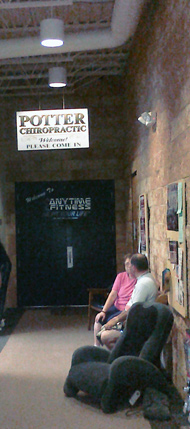Your First Visit to Our Faribault Practice

You will be warmly welcomed and made to feel at home. Help is on its way!
A visit to Dr. Potter will start out like a typical visit to any doctor: the patient will be asked to fill out a patient history. Here the patient will describe in detail the problem(s)he is experiencing: how it happened, when, how often it is felt, how severe; related symptoms, and so on. Dr. Potter will try to pinpoint the causation by asking other questions involving any hobbies/activities, diet, work environment, and medical history of the patient’s immediate family members.
Next, vital signs may be taken: heart rate, blood pressure, respiratory rate. The physical examination will generally be performed through light clothing or you may be asked to put on an examination gown. The exam may include observation of posture and range of motion and palpation of muscles, joint movement, and soft tissues. And depending on the presenting symptoms and complaints, certain orthopedic and neurological tests may be performed. These are tests used to locate the structures involved in the condition and often attempt to provoke the symptoms.
For example, if the patient were to come in for low back pain, I may conduct a straight leg raise test, where the doctor raises the leg of the patient as she is lying down on her back. If it causes low back pain, the test is positive for a herniated or bulged disc. the doctor may also conduct Kemp’s test, where the standing patient bends backwards and twists to one side. Pain going down the leg is positive for disc herniation/bulge on that side.
There are orthopedic tests to evaluate problems affecting the neck, thorax, pelvis, and extremity joints of the legs and arms. The chiropractor will also palpate, or feel the spine for signs of spinal dysfunction such as joint restrictions, muscle spasm, trigger points, swelling, and changes on skin temperature.
Neurological tests are done to evaluate the motor strength and sensory function of major nerves. These tests include the cranial nerve test to test hearing, smell, taste, eye movement, pupil dilation, swallowing., facial muscles, and others; deep tendon reflexes (using a reflex hammer) to test the major nerve roots in the upper and lower extremities; muscle strength tests, and dermatomal tests to evaluate the sensory component of the nerves and nerve roots.
Dr. Potter also uses the Insight Millennium Subluxation Station, our state-of-the-art technology that will help us detect nerve disturbance, document and monitor your results, and deliver the appropriate chiropractic care. This test does not hurt at all. It simply receives important information from your Central Nervous System. Our purpose for administering these tests is to detect and pinpoint abnormal function in the spine which cannot be seen on X-ray.
Abnormal spinal function causes abnormal nervous system disturbance. The three standard tests will measure:
- SEMG – the amount of electrical current in the muscles
- Thermography – skin temperature along the spine
- Inclinometry – range of movement of the spine.
An optional X-ray of the area may be taken to compare the exam findings to the actual area. If the X-ray study is inconclusive, an MRI may be taken to visualize soft tissue structures such as the discs, muscles, spinal cord, and nerve roots. The first visit will take about an hour. So that is what a typical chiropractic first office visit involves. If you are experiencing musculoskeletal pain or symptoms that are not resolving on their own, or want better health through natural chiropractic care, calling Dr. Potter would be a good place to start.
Click here to learn what you can expect on your second visit.
 Request Appointment
Request Appointment Email Us
Email Us

